Eugene Galien Laloue (1854-1941)
Get a Laloue Certificate of Authenticity for your painting (COA) for your Laloue drawing.
For all your Laloue artworks you need a Certificate of Authenticity (COA) in order to sell, to insure or to donate for a tax deduction.
Getting a Laloue Certificate of Authenticity (COA) is easy. Just send us photos and dimensions and tell us what you know about the origin or history of your Laloue painting or drawing.
If you want to sell your Laloue painting or drawing use our selling services. We offer Laloue selling help, selling advice, private treaty sales and full brokerage.
We have been authenticating Laloue and issuing certificates of authenticity since 2002. We are recognized Laloue experts and Laloue certified appraisers. We issue COAs and appraisals for all Laloue artworks.
Our Laloue paintings and drawings authentications are accepted and respected worldwide.
Each COA is backed by in-depth research and analysis authentication reports.
The Laloue certificates of authenticity we issue are based on solid, reliable and fully referenced art investigations, authentication research, analytical work and forensic studies.
We are available to examine your Laloue painting or drawing anywhere in the world.
You will generally receive your certificates of authenticity and authentication report within two weeks. Some complicated cases with difficult to research Laloue paintings or drawings take longer.
Our clients include Laloue collectors, investors, tax authorities, insurance adjusters, appraisers, valuers, auctioneers, Federal agencies and many law firms.
We perform Eugene Galien Laloue art authentication. appraisal, certificates of authenticity (COA), analysis, research, scientific tests, full art authentications. We will help you sell your Eugene Galien Laloue or we will sell it for you.
Eugene Galien Laloue was one of the great artists of the Paris street scene, which he produced in an Impressionist style. His paintings stand out from those of other artists of the day due to the way in which he was able to depict the landmarks and monuments of Paris, giving special attention to the architectural detail.
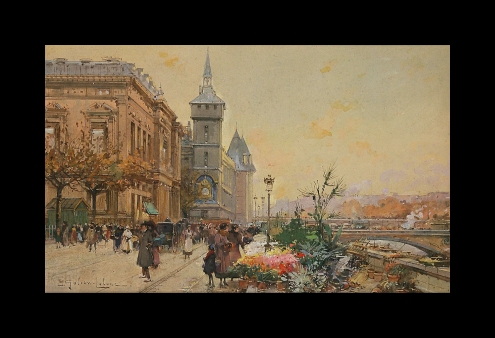
Paris le Marche aux Fleurs
Courtesy Rehs Galleries, Inc., New York
He was born in Paris, in Monmartre, and was one of nine children. After the death of his Father at the age of sixteen, he left school to work in the office of a Notary. However, this was the time of the Franco Prussian War and he quickly left this job to enlist in the army. It is thought that whilst in the military he decided to become an artist. After leaving the army he found a job with French Railways as an illustrator. He produced illustrations of the tracks that were being laid from Paris to the provinces.
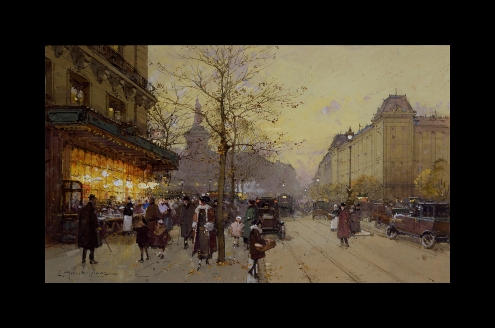
Place de la Republique
Courtesy Rehs Galleries, Inc., New York
He exhibited for the first time at the Museum of Reims with a painting entitled, ‘Flower Market along the Seine under the Snow.’ After that he exhibited at the Paris Salon, and was to exhibit there regularly thereafter. He was said to have taken scrupulous notes of the paintings he sold and the price paid.
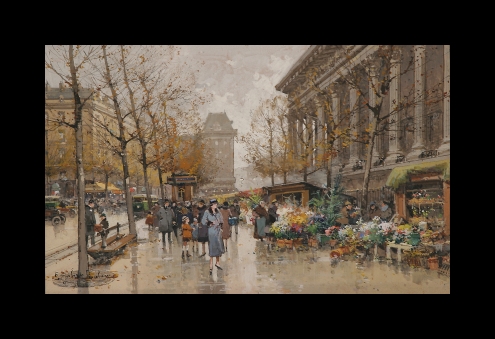
Flower Market
Courtesy Rehs Galleries, Inc., New York
He was to produce paintings of his beloved Paris all his life, and particularly liked to portray the city in Autumn and Winter. He was to go on to produce countless paintings of the monuments of Paris such as the Arc de Triomphe and the Louvre. Many of his paintings tell a story, in that they show what Paris life of the early 1900s, was like, with its horse drawn carriages, trolley cars, bustling boulevards, and its markets. In a sense he was a recorder of the history of the city.
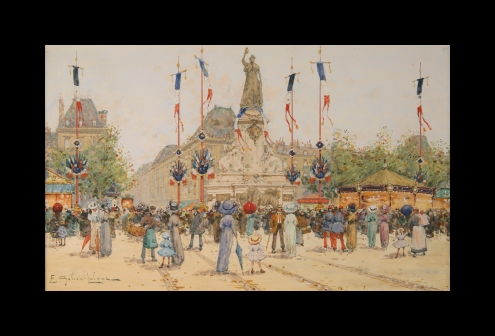
Un 14 Juillet Place de la Republique de la Bastille
Courtesy Rehs Galleries, Inc., New York
He was, however, a solitary figure and did not have close friends among other artists of the day, and also did not like to travel. When he painted other cities, it was from postcards and photographs. He also used pseudonyms, and art historians have said that this was due to his reclusive personality and the wish to remain somewhat anonymous.
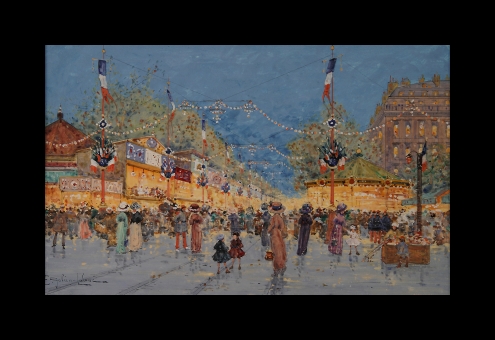
Foire aux Pains D’epicerie La Nation
Courtesy Rehs Galleries, Inc., New York
One of the pseudonyms that he used was J. Lievin. He took this name from the name of a soldier that he met during the Franco Prussian war. He also used the surname Galiany. Galiany was an Italian version of his French surname. His father was Italian. The third name that he was known to have used is Dupuy Leon after someone that lived in his region. There is a possibility that he also used other pseudonyms as well.
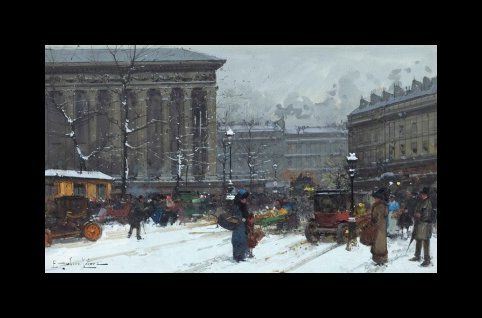
La Madeleine Sous La Neige
Courtesy Rehs Galleries, Inc., New York
Although his notoriety is due to the depiction of Paris street scenes, it should not be forgotten that his paintings dealt with other subjects also. At the beginning of the First World War he was too old to join up and so he took to painting scenes of battle. He paid particular attention to the details of the individual soldiers, and in particular their costumes. He also produced magnificent landscapes of Normandy, and the area around Barbizon, and the Forest Of Fontainebleau. Whereas his Paris scenes dealt with the seasons of autumn and winter, he depicted his landscapes of Normandy and the area around the Forest of Fontainebleau in the spring and summer.
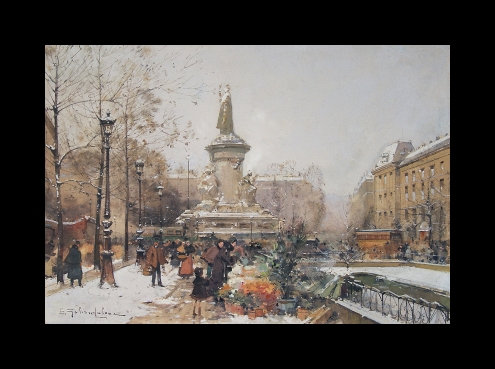
La Place de la Republique Sous la Neige
Courtesy Rehs Galleries, Inc., New York
Eugene Galien Laloue, as a man, is certainly a bit of a mystery, his reclusive nature, and the number of pseudonyms that he used certainly set him apart from his contemporaries of the day. He was also to marry three times, but the strange thing about his marriages was that they were all sisters, whom he married one after the other!
Towards the beginning of the Second World War he went to live with his daughter in the village of Cherence, just a mile or so from Vetheuil, the village where Monet lived for a number of years. It was there that he died.
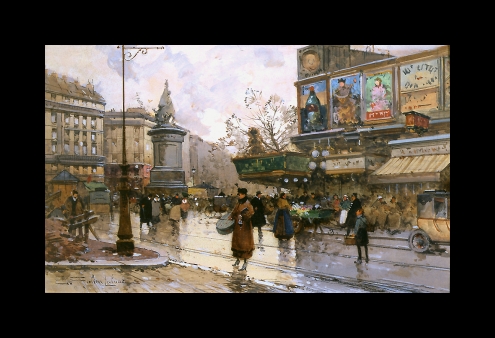
Place Clichy
Courtesy Rehs Galleries, Inc., New York
Paris street scenes by Eugene Galien Laloue are certainly sought after and valuable. If you have a painting of a Paris street scene with particular attention paid to the architectural detail, it is possible that it is by him. The fact that the signature is not Galien Laloue or any of his other known pseudonyms should not discount it as one of his paintings, as art historians believe there is a possibility that he may have used other names as well of which we are not aware. If you suspect you may own a Laloue, please contact us.
Reviews
1,217 global ratings
5 Star
4 Star
3 Star
2 Star
1 Star
Your evaluation is very important to us. Thank you.
